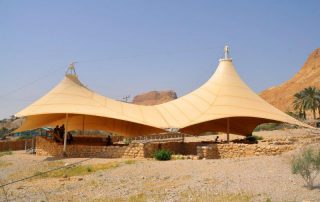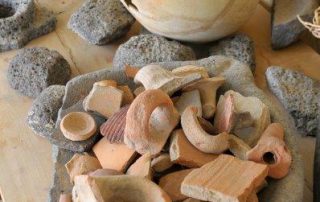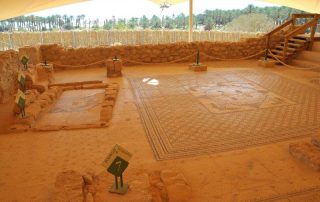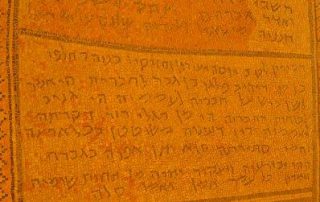Trips around the Dead Sea and Judean Desert
Ancient Synagogue and Beit Tamar
Just a 5-minute drive from Kibbutz Ein Gedi is its ancient site – the village that became a large town in the days of the Mishna and Talmud. Tel Goren is situated at the center of the site – it is a hill made of layers of construction developed throughout the generations. The Tel was never adapted for visits, although visitors can enjoy its expanses – the mountain cliffs on the west, the Dead Sea on the east, Arugot Stream to the south, David Stream to the north – all surrounded by mountain fields and terraces that, to the best of our knowledge, were used for date trees and persimmon shrubs and are now cultivated as mango groves. The synagogue at the bottom of the Tel, situated at the center of the settlement, was excavated and adapted for visitors.
There is an admission fee for visitors at the David Stream Nature Reserve – the price includes the entrance to the synagogue on the same day.
North of the synagogue – Archeological findings of the village homes and streets, uncovered by the archeological team headed by the Late Prof. Yizhar Hirschfeld. This area will also be adapted for visitors in the future.
Visit Ein Gedi on Wikipedia (Synagogue) for information about the village of Ein Gedi, the synagogue, its history and findings, and mainly the long, impressive and legible inscription on the beautiful floor of the synagogue foyer.
Visitors unaccompanied by a guide will be given a binder with information upon arrival and will be able to tour the site independently. The synagogue itself is located under a tent like roof, providing visitors with shade and protecting the beautiful flor. Take a few minutes to read the entire inscription, using the binder as a guide. It is amazing how, 1500 years later, we can still read and understand almost every word.
The Ein Gedi community, mostly Jewish, was probably a special one. The synagogue was unique and the rites of prayer and worship, to the best of our knowledge, were unique to this distant and remote location.
Before descending the moderate slope to the synagogue, we will come across a small garden of local plants, some of which were important in ancient times. We will see the Calotropis Procera – “Apple of Sodom” – whose fibers were used to prepare wicks and probably for weaving quality, delicate and very expensive fabrics. The Indigofera Articulata was grown in the Dead Sea Valley to produce indigo dye – the wonderful color that was so expensive and in great demand. The lawsonia Inermis tree, mentioned in the Song of Songs alongside Ein Gedi, was considered a popular perfume tree and a source of henna that ancient settlers used. Other plants at the synagogue garden are very rare, some extinct, patiently and lovingly restored by gardeners and biologists, such as – the Maerua Carssifolia Forssk, Capparis Decidua, Oxystelma Alpini Decne and the Leptadenia Pyrotechnica. The synagogue garden is thus a plot for acclimatizing and preserving local plants that must be protected and here, at the entrance to the site, you can enjoy them and the sight of blossoming, flowers or fruit.
Last but not least – Beit Tamar (Date House). A structure built by Michal Raz, a member of Ein Gedi, made entirely of natural materials taken from date trees – trunks, fronds, spines, rachis and more. Michal dedicated several years to the study of the craft and use of date sources, which was popular in the hot valleys of the country in ancient times and which slowly disappeared. The Date House is open to guided tours upon prior scheduling (contact Yaelli Gal, +972-8-659-4769, +972-52-858-0267), but anyone who wants to see the open structure, which is a very pleasant hangout, should walk out of the synagogue and see the adjacent structure to the north. Visitors scheduling a guided tour are in for a special experience of getting acquainted with date farming, basket and mat weaving, the culture that still exists in our day (in Morocco, for example) and the story of renewing date cultivation in Israel of the 1950’s.
For more information about the tour, press here.
Written by: Meni Gal
Tour duration
2-4 hours
Difficulty
Medium
Admission fee?
No
Location
Southern Dead Sea, south of Neveh Zohar










